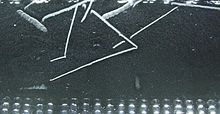Cloud chamber
A cloud chamber is a sealed box with a supersaturated vapour of water or alcohol. When a charged particle (e.g. an alpha or beta particle) goes through it, the vapour is ionized. The resulting ions act as nuclei, around which a mist forms from the vapour.



The high energies of alpha and beta particles mean that a trail is left by ions produced along the path of the charged particle. These tracks have distinctive shapes (for example, an alpha particle's track is broad and shows more evidence of deflection by collisions, while an electron's is thinner and straight). When any uniform magnetic field is applied across the cloud chamber, positively and negatively charged particles will curve in opposite directions, according to the Lorentz force law.
The cloud chamber was invented by Charles Wilson (1869–1959), a Scottish physicist who received the Nobel Prize in Physics in 1927 for this work. The first cloud chamber was made in 1911. The invention was used in the early days of atomic physics. It is often called the 'Wilson chamber'. Since then a number of other types of particle detectors have been invented.
References
change- Das Gupta N.N. & Ghosh S.K. 1946. A report on the Wilson cloud chamber and its applications in physics. Reviews of Modern Physics. 18, 225–365.
Other websites
change- Many pictures of nuclear interaction and experiences[permanent dead link]
- Video demonstration of a cloud chamber Archived 2014-09-14 at the Wayback Machine, Peter Wothers, Royal Institution, December 2012
- Wilson's Original Apparatus Archived 2008-06-30 at the Wayback Machine
- Radiation tracks in Cloud Chambers Archived 2013-07-04 at the Wayback Machine